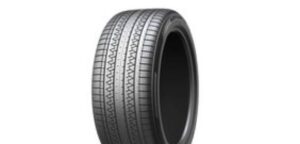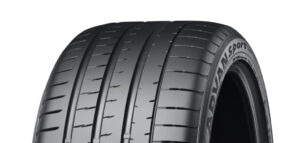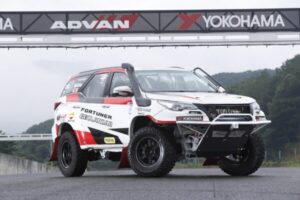When the 1,000bhp EVs of the Nitro Rallycross series went ice racing in Canada, TTI was there to witness Yokohama’s resourceful approach to creating a bespoke studded tire for winter events.
Rallycross was created in the 1960s as a TV-friendly motorsport. Its short-duration, action-packed format is perfect for the digital age, in which extreme sports have garnered huge followings online. But in the past decade, different rallycross series – including an FIA-sanctioned world championship – have struggled to achieve lasting success.
Yokohama has been on board as NRX’s sole tire supplier since the first standalone event in 2018. It initially deployed the 230/640 R17 Advan A054 – a grooved slick rallycross tire originally developed from the A005 racing slick for US-based Global Rallycross, but never raced in that series due to a change in commercial partnerships.
For 2022, the tire supplier faced a fresh challenge with the arrival of NRX’s new headlining class, the all-electric, 1,000bhp Group E cars.
Improvise, adapt, overcome
The interim solution was an existing wet race tire in the company’s motorsport catalog, the Advan
A006 in size 310/690 R19, which was first introduced for ALMS GT racing in 2013. Capable of withstanding the power and torque of the new, SUV-like FC1-X race cars on dirt, it provided an instant fit for Group E’s first season of competition.
“As this was an entirely new vehicle platform, there was extremely limited time for tire testing prior to the start of the racing season,” says Tricia Wall, a former NASCAR engineer who took over as Yokohama’s motorsports manager in 2022. “We conducted baseline testing with the FC1-X and determined the A006 would be best suited for the mix of tarmac and dirt surfaces of NRX’s tracks. We also tested our A005, but the treaded A006 offered better traction on the mixed-surface tracks.
“This first racing season with the NRX Group E class has been a development year,” she continues. “The cars are new and the tracks are temporary, so things are always changing. It’s been a merging of tire, car and track, and we all have to work together to make the series work.
“NRX is a challenging series from a tire perspective. The cars go off jumps and land sideways, sometimes on one corner. They’re mostly on dirt so you get dirt between the wheel and the bead.”
The winter option
When the Yokohama engineers were developing this particular A006 for Ferrari GTs a decade ago, they understandably gave no thought to the prospect that one day it might be studded and used for ice racing. But with two Canadian winter events – in Trois-Rivières, Quebec and Calgary, Alberta – joining the calendar for the 2022-23 season, that’s what happened.
The FC1-X electric cars for Group E were designed and built in Sweden by established rallycross expert Olsbergs MSE (OMSE) in partnership with Spanish electric powertrain specialist QEV Technologies. To create a tire for racing on the ice surfaces planned for Canada, OMSE’s CEO and team principal Andreas Eriksson connected Yokohama with a long-time contact: tire-studding expert Hans Rönnlund, whose BilTek company is based in Morjärv, northern Sweden.
Rönnlund advised that, in studded form, each tire should be good to last both events in Canada, so Yokohama ordered 100 tires to cover the 10-car field – far fewer than for one of the dirt events – with each car allocated eight tires for use across the two events.
“My father discussed the studding options with Andreas,” explains Rönnlund’s son, Nils Vennberg, a BilTek technician who supported the events in Canada. “They considered the ice, the weather, the cars and how many laps of racing. The two options were 12mm or 27mm, but 12mm was the right choice because longer studs, where we are racing now, would have destroyed the track.”
Indeed, given the warmer-than-expected conditions in both Trois-Rivières and Calgary, the state of the specially laid ice tracks was a concern throughout the race weekends. Up to 40cm of ice had been laid in Calgary, for example, but sunny conditions and temperatures the wrong side of freezing led to schedule and layout changes being implemented to preserve the racing surface. Even so, Nitro RX was able to complete both events – in the case of Calgary, in front of a 20,000-strong crowd, its largest ever.
Stud farm
In preparation for the ice-track races, regular A006s were shipped to BilTek, where the tread was shaved to leave a carcass depth of 7mm – enough to preserve the integrity of the tire while allowing the stud itself to be pushed through and secured.
The steel studs used are produced especially for BilTek by an outside supplier to a design honed by Rönnlund over 20 years of supporting ice racing. They are heat-treated for strength, which enables them to flex by around 15% before breaking.
Once the tread has been ground away, a pattern is applied around the inside of the tire and carefully aligned to denote where the studs should be fitted – some 320 of them in the case of the A006, creating a tire with the looks of a medieval torture instrument.
“We’ve tried more than 100 different patterns but with this one you get the best grip and the best braking,” says Vennberg, adding that the design was refined by BilTek and local ice-racing drivers over many years.
Although it might appear random at first glance, the pattern repeats in sections of about 20cm around the tire, with an importance placed on avoiding straight lines to prevent running into an existing hole and to preserve both tire and racing surface.
The studs are pushed through from the inside by machine, the only automated element of an otherwise manual process. The wide, flat head forms a seal on the inside, while on the newly flattened outer surface of the tread area, a washer and nut secure it in place. The nuts are rounded to prevent gradual loosening in use.
It takes more than four hours to prepare a single tire. In the run-up to the winter holiday, Vennberg himself studded around 80 of the 100 tires made for Nitro RX’s Canadian adventure. “They were very long days,” he laughs.
Once the tire is mounted on the wheel, Carlisle TyrFil is pumped in through the valve stem. Yokohama’s technicians then rotate each tire 45° every 15 minutes to make sure that the liquid fills in any gaps, ensuring the tire is sealed from the off.
On the ice
In use, the studded tires proved just as durable as Rönnlund had predicted. Only two were deemed irreparable after the Group Es had raced at Trois-Rivières. To preserve the structure of the tire in the cooler ambient temperature at both Canadian rounds, Yokohama took the decision to raise the minimum recommended tire pressure from 2.1 bar to 3.8 bar, with a recommended pressure of 4.3 bar. Yokohama’s Wall notes that, at both venues, the pressure dropped off by 0.2 bar as soon as the cars went outside from the heated indoor paddock area.
In Calgary, four tires were confiscated during the race weekend after a team was found sharpening the studs. NRX tire regulations stipulate that the tire may not be chemically or physically altered in any way. Whether sharpening would have led to better performance is debatable, according to Vennberg, who reports that BilTek had not experienced such a benefit with its studded race tires in the past.
The next step
More generally, tire wear was not an issue with the GT-derived tire on the mostly dirt surfaces raced by Nitro RX during the 2022-23 season. But with a potential 1,000bhp on tap – the FC1-X cars are currently detuned for driveability on tight, loose-surfaced tracks, not to mention to keep the cars intact on the huge jumps that are an NRX staple – Yokohama knows that something more bespoke will be required in the future.
“As Nitro Rallycross tries to go to more tarmac and fewer dirt tracks on next year’s schedule, we’ll need to make an improvement,” says Wall. “A wet tire is not made for tarmac. We are in the process of developing and testing improved A005 and A006 tires with the goal of launching these improvements for the 2023-24 season.”
Yokohama tested at Glen Helen in California after the season-closing NRX event back in March to evaluate the improved A006 tire. It then headed to the abrasive Horse Thief Mile track, also in California, to test the upgraded A005 on asphalt.
“If the 100% dirt tracks at Glen Helen and ERX Motor Park, Minnesota stay on the schedule, we’ll probably have a couple of different tire options, depending on the track,” Wall says. “As the series evolves, we’re going to have to evolve with it. But everyone races on the same tire, so too many different tires [for different tracks] would be difficult for us logistically and an added expense for the teams.”
NRX logistics
The Advan A006 tires used in Nitro RX, like all of Yokohama’s racing tires, are made in Japan. Each of the 10 Group E cars is allocated two sets per race weekend. Also supplied are tires for the Next cars – ICE-powered machines for younger drivers – and a third class for Can-Am side-by-sides (SXS). The volumes are not huge, but as Yokohama’s Tricia Wall says, “It’s still been a logistical challenge, especially in the last year where you’ve had containers stuck offshore for months on end.” For the European rounds at the start of the 2022-23 season, some tires were shipped from the US while others went directly from Japan.
Reference: tire Technology

 English
English


